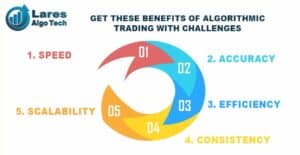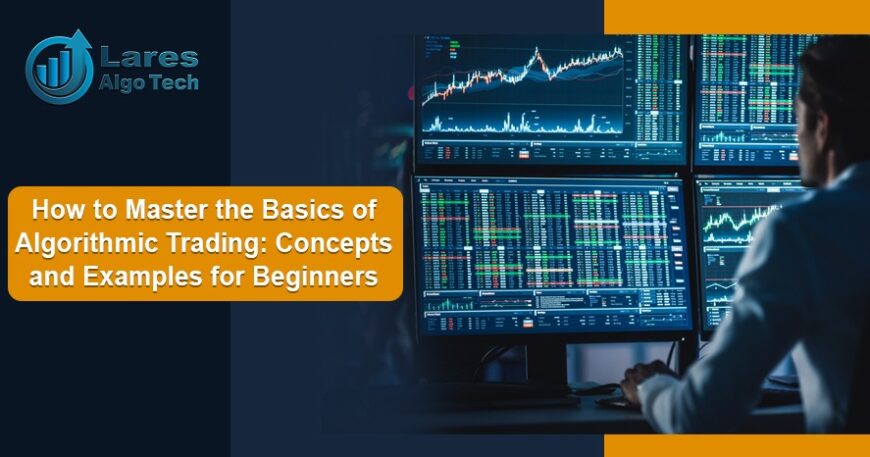Algorithmic trading, or algo trading, is a form of automated trading that uses computer programs to execute orders based on predefined rules or criteria. Algo trading can help traders and investors save time, reduce costs, enhance performance, and benefit from market opportunities. In this blog post, we will cover the basics of algorithmic trading.
Let’s Understand the Basics of Algorithmic Trading and How Does it Work?
Algo trading is a trading technique that involves using coded instructions or algorithms to place orders in the market. The algorithms can be based on various factors, such as price, volume, time, indicators, patterns, or other mathematical and statistical models. The algorithms can also be programmed to adapt to changing market conditions and optimize trading performance.
Every Algo trading company works by scanning the market data and generating trading signals based on a predefined set of rules. When the signals match the criteria, the algorithms execute the orders automatically, without any human intervention. Algo trading can also be used to split large orders into smaller ones, to reduce the market impact and improve the execution quality.
Algo trading can be applied to different types of markets, such as stocks, futures, options, commodities, currencies, and bonds. Algo trading can also be used for different trading objectives, such as arbitrage, market making, or portfolio optimization.
What are the Benefits and Challenges of Algorithmic Trading?
In the Basics of Algorithmic Trading, We’ve discussed the Benefits and Challenges of Algo trading over manual trading, such as:

- Speed: Algo trading can process and execute orders much faster than humans, which can give an edge in a fast-moving market.
- Accuracy: Algo trading can eliminate human errors, such as miscalculations, typos, or emotional biases, which can affect trading decisions.
- Efficiency: Algo trading can reduce transaction costs, such as commissions, and spreads, by finding the best prices and timing for the orders.
- Consistency: Algo trading can follow the trading plan and strategy without any deviation, which can ensure a consistent performance over time.
- Scalability: Algo trading can handle multiple markets and instruments simultaneously, which can increase trading opportunities and diversification.
Challenges and Risks of Algorithmic Trading
In the Basics of Algorithmic Trading, We’ve discussed the challenges and risks of Algo trading over manual trading, such as:

- Complexity: Algo trading requires a lot of technical knowledge and skills, such as programming, mathematics, statistics, and finance, to design, test, and implement the algorithms.
- Maintenance: Algo trading requires constant monitoring and updating, as the algorithms may become obsolete or malfunction due to changing market conditions, data errors, or system glitches.
- Competition: Algo trading faces a high level of competition from other algo traders, who may have more advanced algorithms, faster execution, or better access to market data and liquidity.
- Regulation: Algo trading is subject to various rules and regulations, such as the Securities and Exchange Board of India (SEBI), which may limit the scope and flexibility of the algorithms.
What are the Types of Algo Trading?
Algo trading can be classified into different types, depending on the frequency, duration, and objective of the trading. Some of the common types of algo trading are:
- High-frequency trading (HFT): This is a type of algo trading that involves placing a large number of orders in a very short period, usually milliseconds or microseconds, to capture small price movements and market inefficiencies.
- Low-frequency trading (LFT): This is a type of algo trading that involves placing a smaller number of orders in a longer period, usually minutes, hours, or days, to capture larger price movements and trends.
- Medium-frequency trading (MFT): This is a type of algo trading that involves placing a moderate number of orders in a medium period, usually seconds, minutes, or hours, to capture intermediate price movements and signals.
What are the strategies of algo trading?
Algo trading can also be classified into different strategies, depending on the logic, data, and indicators used by the algorithms. Some of the common strategies of algo trading are:

1. Price Detectives: Arbitrage
This strategy uses algorithms to find tiny price gaps between the same asset on different platforms, and then take that profit opportunity.
2. Market Making
Market Makers provide liquidity (think easy buying and selling) by constantly setting both “buy low” and “sell slightly higher” prices for an asset. They earn the difference between those prices like a small commission for keeping the market flowing smoothly.
3. Trend Following
Trend following does something similar in the market. Using fancy math and technical analysis, algorithms pick out the “uphill” and “downhill” trends of an asset and tell you when to jump in and out to trade accordingly.
4. Momentum
This is a strategy that involves trading in the direction of the strength of the market or an asset, and riding the momentum until it fades.
5. Mean Reversion
This strategy looks for assets that have gone way up or down too quickly and become “overvalued” or “undervalued.” It then predicts (using math, again) when they’ll snap back to their normal price range, allowing you to profit from that “correction.”
6. Breakout
Breakout trading is like watching for that moment in the market. It uses special tools to identify when an asset’s price is stuck within a certain range and then explodes outside of it. By spotting these breakouts early, traders can potentially grab big profits from the sudden price surge.
7. Swing Trading
Swing trading, It looks for short-term swings in an asset’s price, buying during dips and selling during peaks.
Remember, these are just simplified explanations. Each strategy has its complexities and risks. Be sure to research and understand them thoroughly before diving in with real money. Last month, We posted a blog on strategies of algo trading in India. You must get the 5 powerful strategies that can help you beat the market.
How to start algo trading in India?
To start algo trading in India, you need to follow these steps:
- Step 1: Learn the basics of algo trading, such as the concepts, types, strategies, benefits, and challenges of algo trading. You can use online courses, books, blogs, podcasts, or webinars to learn about algo trading.
- Step 2: Learn to code or use a programming language, such as Python, C++, or Java, to create, test, and implement your algorithms.
- Step 3: Backtest your strategy or algorithm on historical data, to check its performance, validity, and robustness.
- Step 4: Choose the right platform or broker, to execute your algorithm in the live market. You can use platforms or brokers, such as Lares Algotech, Zerodha, Upstox, or Angel Broking, to access the market data, liquidity, and API services for algo trading.
- Step 5: Go live or deploy your algorithm in the real market, and monitor its performance, behavior, and results.
FAQs on Basics of Algorithmic Trading:
1. Do algo trading work?
The short answer is: it depends. Algo trading can be effective. Its success depends on several factors:
- Algorithm design: Your algorithm needs a sound trading strategy and robust mathematical models to analyze market data and make profitable decisions.
- Market conditions: Some market environments might be more suitable for your chosen strategy than others. Adaptability is key.
- Execution and risk management: Fast execution and effective risk management tools are crucial to capture opportunities and prevent losses.
2. Can algo trading be profitable?
Yes, absolutely! Many algo traders achieve consistent profits, but it’s vital to remember that past performance doesn’t guarantee future results. Profitability depends on the factors mentioned above, along with your dedication to learning, testing, and adapting your algorithms.
3. What is algo trading with an example?
Imagine a simple trend-following algorithm programmed to buy a stock when its price crosses above a moving average indicator and sell when it falls below. This strategy aims to capitalize on upward trends while minimizing losses during downturns. However, market realities are complex, and such a basic strategy might not always be successful.
4. Is algo trading legal in India?
Yes, algorithmic trading is completely legal in India. The Securities and Exchange Board of India (SEBI) regulates it, ensuring transparency and fair market practices. Several Indian brokerages offer specialized platforms for algo trading.
5. Algo Trading in India:
India’s algo trading market is booming, with a significant portion of trading volume now facilitated by algorithms. This growth is driven by factors like:
- Technological advancements and increased access to data
- Rising sophistication of trading strategies
- Competitive brokerage platforms catering to all traders
6. What is Algorithmic Trading in the Indian Stock Market?
In the Indian stock market, algo trading involves using computer programs to execute trades based on pre-defined rules and analysis of market data. These algorithms can:
- Analyze technical indicators for trading opportunities
- Generate orders and execute trades automatically
- Monitor risk and manage positions to minimize losses
7. Which is the Best Algo Trading Platform in India?
There’s no single “best” platform, as each caters to different needs and experience levels. Popular options in India include:
- Lares Algotech: User-friendly and affordable, ideal for beginners.
- Zerodha Kite: Robust platform with strong research and backtesting capabilities.
- Upstox Pro: Feature-rich with advanced order types and analytics tools.
In conclusion, algo trading has become an increasingly popular form of automated trading that uses computer programs to execute orders based on predefined rules or criteria. With its numerous advantages such as speed, accuracy, efficiency, consistency, and scalability, algo trading has the potential to help traders and investors save time, reduce costs, enhance performance, and benefit from market opportunities.
However, it also comes with its own set of challenges and risks, such as complexity, maintenance, competition, and regulation. As such, traders and investors need to have a solid understanding of the basics of algo trading, including its types and strategies, to make informed decisions. By mastering the basics of algorithmic trading, beginners can develop their skills and knowledge to become more successful traders in the long run.





